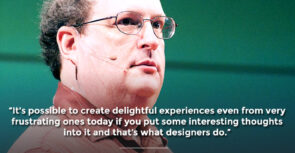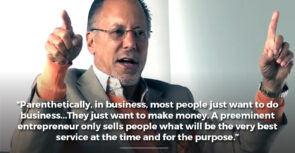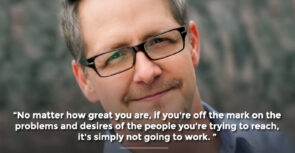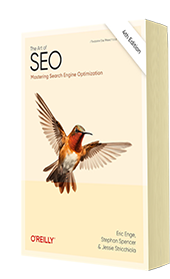INTRODUCTION
In this episode, I had the pleasure of talking with the brilliant Dan Kennedy, the godfather of direct marketing. Dan has shared stages with other luminaries like Tony Robbins and Zig Ziglar. He’s worked as a marketing advisor and consultant to business owners and CEOs of businesses ranging in size up to $1 billion. He reached this professional pinnacle by the depth of his knowledge of marketing, which he generously shares in this conversation.
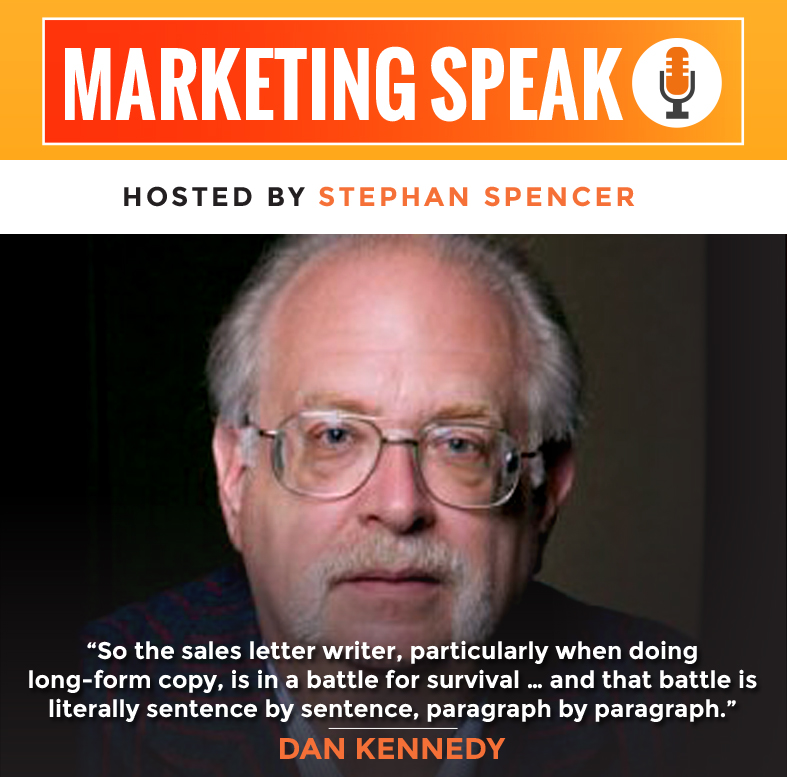
In this Episode
Transcript
Hello and welcome to Marketing Speak. I’m your host Stephan Spencer. Today, I have the distinct pleasure of inviting on the show Dan Kennedy. Dan is the provocative truth teller, the bestselling author of 13 business books, a serial entrepreneur, a multi-millionaire, trusted marketing advisor, consultant and coach to hundreds of business owners and CEOs of businesses ranging in size from $1 million to $1 billion. As a speaker, Dan has shared stages with US presidents, with Zig Ziglar, Brian Tracy, Jim Rohn, Tony Robbins, and countless sports and Hollywood celebrities. Dan has addressed audiences as large as 35,000 people. Over the last ten years, his average is speaking to more than 250,000 people per year. It is such an honor and privilege to have the godfather of Direct Marketing join us on today’s podcast. Dan, thank you so much for joining us today. Let’s start with what are the essential components for an effective sales letter.
To begin with, there’s the requisite understanding that a sales letter or alternative substitute for a letter, video sales letter online, speech delivered from the stage, they’re all really the same thing. The requisite understanding is that their purpose is to sell. Therefore, rule books that apply to other kinds of documents and other kind of writing do not necessarily apply here. In another time and a simpler media world, this was explained to people has sales been shipping print. Today, it’s more accurate to say sales has been shipping media. But that’s what we’re doing, we’re replicating to the greatest extent possible in a sales letter how we would sell if we were face to face with that same prospect at the kitchen table in their home or at the conference, the big board table in their conference room or across their desk. We’re not doing anything less and we’re not doing anything more. Consequently by the way, often transcripts of sales presentations by a company’s best salespeople form the basis for a lot of sales letter copy. Then, the most important essential is choosing a structure. There’s classic sales architecture, attention, interest, desire, action, problem, agitate, solve, story, the same structure is a hero’s journey for a story. You pick the structure that is most appropriate to what you’re doing. Then, you begin to fill in the blocks.
The Kennedy system, does that focus on one particular approach like AIDA — attention, interest, desire, action — or does that include multiple different—
It can work within different architectures. The Ultimate Sales Letter book itself presents a 28-step system but really any structure. I am partial too, and in the absence of any compelling reason not to use it, if you look at a lifetime of my copywriting for self and for clients, you will see that I tend to default to problem, agitate, solve or a slightly expanded version of that which is problem, agitate, problem, invalidate all solutions except mine, and then the solution. Barring a reason to deviate from it, I usually use that one. It’s extremely reliable.
Awesome. I’ve been going through The Ultimate Sales Letter book which is fantastic. You’ve got headline formulas in there, you have just a whole process with multiple steps. Let’s actually kind of go through a few things. The headline is one of the most critical elements of an effective sales letter. Why don’t we start with the headline? How do you craft a killer headline?
You grope, actually. You’re looking for the compelling benefit. You may go all the way to the offer and come backwards if you have a really strong guarantee you’re going to go from that, if you have a big price advantage you go from that. You decide what you’re going to feature in the headline. Then, you can go into the examples that are in the book or others and you pick one to swipe, to borrow, to model, to now fit your content into. That’s a real shortcut for a lot of people. It turns this into a sort of a Chinese menu exercise, pick one from column A, one from column B. The top real estate of a sales letter is the top third of the first page. Typically, there’s going to be a main headline, there’s going to be a secondary headline, and in many cases, there’s going to be a pre-head. The pre-head could be very, very simple. It could be nothing more than “Free Report Reveals…” and then the headline is the promise statement. But for all of those three that comprise that real estate, you get to shortcut by going into classic successful headlines and borrowing them as a fill in the blank, a mad libs exercise, of your own. So, Caple’s famous headline “they all laughed when I sat down at the piano until I started to play…”

Yeah, I love that one.
You can take, ‘they all laughed and until I started to blank,’ you can really plug in almost anything. It’s such a reliable idea. These people are underestimated, and distained, and disrespected, and sometimes mocked. And then their triumph—we just had a presidential election all about that. They get to say, “See, you were wrong. I told you so.” What is important to understand is that the headline is really a headline for the rest of the letter or the ad as much as it is for the product, service, or offer because one of our jobs in writing a sales letter is survival. It is getting the person to move on from headlines to first paragraph without throwing us in the trash and then getting them to move from first paragraph to second paragraph without throwing us in the trash etc, etc, etc. The sales letter writer particularly when doing long form copy is in a battle for survival and retained detection and an opportunity to build interest. That battle is literally sentence by sentence, paragraph by paragraph, subhead by subhead, page by page.
How long should a sales letter be?
Long enough to do everything you need to do to get the desired result. Length is a debate as old as civilization. Every so often, at least once every few years, the advertising community pronounces long copy dead. New media comes along in which everybody insists long copy can’t function and long presentations can’t function, and it’s always wrong. Again, we’re doing selling by media. If you went to the trouble to book an appointment for a salesperson who worked for you and you sent that sales person out to a qualified prospect in order to have a meeting with him and make a presentation. You would almost certainly not impose a time limit on that sales person, particularly not a short one. You would not say, “No matter what, no matter how interested the person is, no matter how engrossed they are, no matter how many questions they have, you got to get in and out of there in 17 minutes.” We wouldn’t do it to a salesman. We ought not to do it to the sales media. Personally, I almost never write to a predetermined length of anything. Even when doing things that do have finite word counts like a full page magazine ad or a 28 ½ bene TV infomercial. I won’t bind myself, I will overwrite and cover every base and do everything I know how to do to make that case. Then if I must, I will come backwards in order to cut and force it to fit the space I’m allowed. I was just at an event, I’ve co-authored a couple of books with Craig Simpson, The Direct Mail Solution is one of the books. Craig brought me one of the newest pieces he’s mailing for a client and it’s 84 pages long. It’s kicking butt and taking aim. I have an online video, I literally just talked to the client today, about an hour ago. I have an online video that prospects are driven to by direct mail. The online video converts 18%, it’s 47 minutes long. The issue about length—you don’t want to be long just to be long. You want to be long in order to be effective. But the issue about length is really about how good you were at delivering your sales letter to an eligible prospect and about your ability to interest that prospect. There is no length that is too long for a rapidly interested person in a topic. There is almost no message short enough for a disinterested prospect in a topic.
Got it. Let’s go back to this idea of swiping other people’s effective ads and sales letters. There’s a thing called a swipe file that some of our listeners are not going to be familiar with that terminology. What if you pick a bunch of ads, sales letters that you believe are effective but they weren’t necessarily and so your swipe file, your compiled list of favorite sales letters isn’t really that good. It’s great if you just go to the Ultimate Sales Letter book and you swipe from the headline formulas like the one that we just talked about, ‘they all laughed until I ranked number one in Google’ or whatever. What if it’s not in the book? What if we’re pulling from other people’s?
If you don’t know, you run the risk of driving yourself off a cliff. First of all, we use the term swipe file colloquially. None of us really mean outright swipe and particularly if material is current and protected by copyright. What we mean is be inspired by, is borrow from, and cobble together from but always putting a fresh coat of opinion on it that is yours. Now, in building reliable swipe files, first there is commercially available material. As you say, there’s stuff in the sales letter book that is proven and tested repetitively successful, classic. There are all sorts of other resources. Million-Dollar Sales Letters by Denny Hatch, Greatest Sales Letters published by Dartnell. If you do a little search for this, there’s dozens of compiled and published swipe file books often with analysis and with results. AWAI online, American Writer and Artists has several of these as well. If you’re working in a category, health, get rich in real estate, online marketing, industrial chemicals, whatever it is that you’re working in. If you get yourself on the mailing list of direct mailers in that field, and you now pay attention to all the mail you get–in alternative health for example all you have to do is buy from three and in three months you’re going to need a wheelbarrow to carry your mail everyday. What you want to look for are the pieces that you are receiving repetitively and over more than three months because you have a control on your hands, you know that they have tested this, they have run other things against it, and they are continuously mailing, it’s working. You can also, there’s a service called Who’s Mailing What. One approach to direct mail, let’s say you wanted to mail an offer to small business owners about how you are going to revolutionize their use of Google. You would go hunt for lists and let’s say four or five response list that you want to mail to, that you want to test, you can go in there. Let’s say one of those lists is Ad Age. Let’s say it’s Advertising Age subscribers. You could then go to Who’s Mailing What and say, “I want to see the control pieces of the other mailers who are using the Ad Age list.” Now, you have again, reliable controls. You know they’re working.
Got it.
From all this, you are first of all getting a sense of the person at the other end of this marketing. Secondly, you’re looking for commonalities. If kind of everybody is using language at an 8th grade level, you do not want to use language at a college level, vice versa. If everybody is using heavily illustrated sales letters that help the reader along, you probably want to use an illustrated sales letter too. You’re looking for commonalities. And then third, you’re looking for inspiration, you’re looking for ideas, you’re looking for ways that they tell their story, not copy to try and take verbatim with three words changed but it kind of looked that everybody is using price analogies so I’m going to do a three-paragraph price analogy on my own. That sort of thing. As you build up actual swipe files and I have a room, you may well go pour through a file door full of guarantee samples before you go write your latest guarantee, or if you really get experienced at this, I tend to only use it now on the backend. I write but then I may consult my swipe files to see if I left anything out, if I missed anything.
What would be a great guarantee speaking of guarantees. What works the best?
Often, multiple guarantees work better than single. Guarantee number one, guarantee number two, guarantee number three. Pure risk reversal works better than conditional risk reversal. At least one of your guarantees is ideally pure. By that, I mean it’s a simple and straightforward although it may be creatively languaged satisfaction, 100% refund guarantee. No strings. You bought this real estate course and you have to make five offers and show that five people rejected you before you get a refund. That’s a conditional guarantee. It can have its place but I wouldn’t want to use it unless I was also using a pure guarantee. Guarantees that are, when they’re ordinary, then copywriting comes into play. And so we had for years, my client for Victoria Principal Skin Care, we had Victoria delivering in the infomercial the bottom of the jar guarantee. Albert wrote, one of the best ever in skin care for Nancy Kwan, and it was if your friends don’t actually accuse you of having had a face lift, return the empty jar for a full refund. All that is is a satisfaction guarantee, but a copywriter has done his job with it. Some guarantees are money bag plus. In the seminar industry, we will sometimes use first day bail out. If by [3:00] in the afternoon you’re not absolutely convinced by number one, number two, number three things, and you want to leave, we’ll not only refund your money but we’ll pay your hotel fare and reimburse your airfare. You have to be pretty sure of your customer and you have to be pretty sure of your deliverable to get into this territory, but these kinds of guarantees can be extremely powerful. When you can’t guarantee results, you can guarantee satisfaction, you can guarantee we’re going to be there within 30 minutes or less. You can almost always find something to guarantee. Then, the copywriter’s challenge is to decide where to put it, do you lead with it, do you wait till you’re dealing with price, etc. etc. Sometimes, you will tease with it early and place the whole guarantee later even all the way into the headline. If our headline was going to be, “Lose no less than 15 pounds in the first 45 days. You are on the miracle grapefruit diet.” If we stick a hyphen in the word guaranteed on it, we know tease the fact that there’s going to be a guarantee.
Got it. I’m assuming that you test this to make sure that the placement is in the most optimal place.
The only way we ultimately know anything is by what the buyers tell us. That now gets to testing one variable at a time. For example, you just named one, where do we put the guarantee? If we’re split testing—you’re either split testing or testing against a control. I’ll tell both. If you’re split testing, you are mailing three different versions of the sales letter at the same time, 5,000 are getting version A, 5000 version B, 5,000 version C. If you’re testing it online, of course you can rotate the traffic going to it 1, 2, 3, 1, 2, 3, 1, 2, 3. It’s the only variable you’re going to be able to test at one time. This gets painful. If you test against a control, you have arrived at a sales letter or for that matter an ad, or a website that delivers a satisfactory result, you could live with it if you never made it better. Then, you test a different sales letter against it and it almost doesn’t matter the variables. You are testing one whole new presentation against an existing presentation. If you win, the thing you just tested becomes the new control and here we go again. In some cases, that process, or the split test process, particularly with mail, may very well yield two or three or four or five that all work about the same. That’s often very good news because you’re able to rotate them through the same productive list and they all work.
Okay. As far as a VSL, a video sales letter, any particular best practices there that are different from the traditional sales letter that you would mail through direct mail?
The architecture is exactly the same. The major decisions are all the same. What are we going to lead with, what should the headline be, what’s the offer, what’s the guarantee, where’s the proof, what order do we put it all in? All of that is the same. By the way if we were buying, if we have an eight-page sales letter, if we were buying eight consecutive pages in the yellow pages in our category, if we were buying eight consecutive full pages at a magazine, all of these foundational decisions do not change. What now changes for the video sales letter is that they are watching TV regardless of what they’re watching it on. But once it’s on the screen, it’s television. We all have certain expectations for what’s supposed to happen with TV. Today, it has to be mobile friendly because a huge amount of this content is consumed through your handheld device, not your desktop device or your television set. That’s technical stuff. In terms of the presentation itself, you now have mostly a viewer who has not committed to dedicated viewership as much as a direct mail reader does. When you deliver particularly a long form direct mail piece envelope and package, most people make a decision to put that in array pile, sit down at their desk or in their chair, in their living room, they got themselves a beverage and they’re giving it dedicated attention. They’re watching your VSL, they’re in Starbucks watching it on their damn phone and there’s a lot going on, and there’s a lot of temptation to go do something else. It’s very kin to the world we live in on TV with infomercials and somebody has a clicker in their hand. Our joke in the infomercial business is if there’s not a car crash or a hot-looking babe roughly every three minutes, you’re in trouble on television. How are we going to overcome that? You got to be really good and you got to think about what happens if they click in here, what happens if they stop paying attention for three minutes and they come back. Now, what is done visually is important as are the words. What they’re looking at. You can do some PowerPoint slides with voiceover, but I am opposed to a complete PowerPoint presentation. If I’m producing them, I will almost always mix live video, stock photos, illustrations, cartoons, charts, graphs, some PowerPoint presentations, and really not stay with any one thing for more than a couple minutes.
That’s a great tip. Going back to direct mail, you eluded to this A pile concept. Most people are sorting their mail over a wastebasket and there’s an A pile, there’s a B pile. Could you just elaborate a bit on what these piles are and how to get into the A pile, how to have something that really stands out, whether it’s lumpy, or it’s oversized, or maybe it’s delivered in a different way like through FedEx or maybe it’s in a tube.
You got it, it can be all of those things. The C pile is trash, the B pile is, “Eh, I’ll look at this when I have time. Maybe.” The A pile is either, “Oh boy, bolt the door. I’m going to go through this right now,” or “This is going in my stack for this afternoon, for tonight, for tomorrow morning while I have my coffee.” Before you get to the tactics that you rattled off, the strategic issues are message to market match, obvious specific relevance, and goodwill. Let’s say for example we’re going to mail to dentists. If we’re not known to them and we don’t have goodwill to them, who is known to them and has generally goodwill to them? Peers, other dentists. One tactical decision is, “Okay, I’m going to do the envelope with permission from a happy dentist customers of mine and I’m going to justify what I did with a little lift note inside from the dentist rather than send it from me or from my company.”
Okay.
I got a big bump years ago for fundraising for the Statue of Liberty Restoration Foundation which was all the fundraising used Lee Iacocca who was then just retired from president of Chrysler and was very well-known in the business world. I simply changed the outside of the envelope from the Statue of Liberty thing to Lee Iacocca. There’s the issue of recognition, reputation, respect, but I’d love goodwill. Does this piece that is arriving have any goodwill with its audience? The other specific relevance is really important especially if you’re going to disclose that you’re not going to try to pretend this is personal mail from grandma and so as soon as it appears to be business mail, you’re going to put some kind of quasi-headline on the outside called teaser copy, maybe you’re going to reveal the business name and so forth.
Okay.
Everybody has something that is their thing; maybe you’re a golfer or maybe you’re a bird watcher, maybe you’re a gardener, your occupation. You have a thing or two that is your thing. If your thing is fly fishing, and something arrives in your mail that clearly has to do with fly fishing, it’s going in you’re A file and maybe you’re going to bar the door and open it before opening anything else. That’s the power of specific relevance. Strategically, if we can get both those things to help us, we want it. Then the tactical stuff you talked about, if transaction size or customer value warrants it, I use FedEx with my clients a lot. Lumpy can make a difference because curiosity killed the cat and forced us to open the envelope. All of those tactical things matter, but the strategic things are very important.

Using FedEx for example has been very effective. For me, I used to own an agency called NetConcepts and we would send these FedEx tubes to prospects, more like suspects, they didn’t really know who we were yet but they contained wool hunting socks from Cabela’s. Cabela’s was a client, we ranked number one, we helped our client rank number one for wool hunting socks and hunting socks and so forth. That was our tie-in. Very tactical but it would have been more effective if we had done what you had described with the dentist and had a letter from the client or have it actually be from Cabela’s with, what do you call the post-it note?
It’s just a lift note. It could be the client’s best testimonial. You’re right, it might have been even more effective. Our client right now who is emailing, well he’s sending a free book as a prospecting device.
Seems a lot.
We built an exterior package that looks exactly like Amazon but a little better. It looks like you got a book you ordered from Amazon.
Another technique that I’ve heard as successful is ordering the book from Amazon. If you have a prime account.
We did that.
With a note. Let’s go to just one final question. There’s some kind of secret techniques that maybe use NLP or kind of embedded commands or something like that or something else that’s not really well-known like urgency, scarcity, exclusivity, that sort of thing. What would you share with our listeners so that they can start incorporating them?
It’s pretty advanced. I’ll give you a pretty advanced one. You won’t find it in the sales letter book, and really a lot of copywriters don’t talk about it. It’s a reverse cold read. A cold read is what a psychic, a mind reader, the people who pretend to get you messages from your dead uncle, it’s what they do to you in order to be able to convince you that they have psychic power. They are really engaged in a combination fishing expedition in a way of describing you back to you that you agree with. These scripts date all the way to the 1800s. They’re actually sort of mad libs, fill in the blank, general enough that they get what are called a lot of hits. They get misses, people kind of forgive the misses and they get a lot of hits. A reverse cold read is I don’t have the opportunity to sit across from you face to face but I know enough about the list you’re from, the profession you’re from, the audience you’re from that I can do this in copy and I can describe you to you as the reason why you receive this and are going to want it. If people Google cold read or cold reading, or they go to Amazon and enter cold read or cold reading, they will find resources about this and they will find both expose books and they will find actually how-to books. Highly skilled copywriters tend to build this into their copy a lot.
Yeah, that’s awesome. Pick up artists use cold reading as well.
Absolutely. If you read Neil Strauss’ The Game.
I’m in a secret society. I know all about his techniques. Very cool. Well, thank you so much. I know you have to go. On behalf of all my listeners, we greatly appreciate you sharing your expertise. You are the godfather of direct marketing and sales copywriting. What an honor it was to have you on this interview. Thank you so much.
Thanks for listening. And if you’re interested in learning more about sales copywriting or direct marketing, be sure to check out Dan’s books. He has over a dozen of them, all available in Amazon of course but in particular check out The Ultimate Sales Letter and No B.S. Direct Marketing. And of course, I want you to visit www.marketingspeak.com for the show notes from this episode and the transcript and also we’re creating a check list of actions to take from this episode, so if you’re wanting to take your copywriting to a whole other level do go to the website and get those show notes and the checklist. Alright guys, I will catch you on the next episode. This is Stephan Spencer signing off.
Important links:
- Dan Kennedy on LinkedIn
- Zig Ziglar
- Tony Robbins
- The Ultimate Sales Letter: Attract New Customers. Boost Your Sales.
- he Direct Mail Solution: A Business Owner’s Guide to Building a Lead-Generating, Sales-
- Driving, Money-Making Direct-Mail Campaign
- No B.S. Direct Marketing: The Ultimate No Holds Barred Kick Butt Take No Prisoners Direct
- Marketing for Non-Direct Marketing Businesses
- Swipe file
- Who’s Mailing What
- Split testing
- Cold reading
Checklist of powerful actions to take
- Now that you have a new understanding of the essential components of an effective sales letter, try rewriting yours while keeping these aspects in mind.
- Construct a sales letter using the problem-agitate-solve structure. After all of his experience in the field, this is the structure Dan recommends.
- Write your sales letter with no regard to how long it is, even if you have a word limit. Instead, overwrite as much as necessary, and then cut the content back to meet the word count.
- Start building your own swipe file. When you come across effective or compelling marketing examples, save them for future reference and inspiration.
- Decide what you’re going to feature in the headline of your sales letter. From there, craft a headline that lets that message shine instead of getting distracted by other points.
- If you get stuck, use your swipe file to play mad libs with headlines. Swap your message into the structure of effective headlines for inspiration and ideas.
- Look for commonalities among effective sales letters in the same market. When creating your own copy, stick close to these commonalities; they probably exist for a reason.
- Use split testing on your marketing copy to determine what you’re doing effectively and what needs improvement.
- When sending an advertisement in the mail, use FedEx or send lumpy or unusually shaped packages. This will help increase your chances of getting into your recipients’ mail A-piles.
- Incorporate reverse cold reading techniques into your marketing. In other words, use what you know about your audience to describe them to themselves.
About Dan Kennedy

Dan S. Kennedy is the provocative, truth-teller bestselling author of thirteen business books a serial entrepreneur multi-millionaire trusted marketing advisor, consultant and coach to hundreds of business owners and CEOs of businesses ranging in size from $1- million to $1-billion.
As a speaker, Dan has shared stages with U.S. Presidents, Zig Ziglar, Brian Tracy, Jim Rohn, Tom Hopkins, and Tony Robbins and countless sports and Hollywood celebrities.
Ten consecutive years, he averaged speaking to more than 250,000 people per year.
Download this free checklist as a pdf.
Comments
Check Out These Relevant Episodes
